5 Ways to Drive Customer Engagement in the Telecom Industry
Customer experience is the top area where telcos must differentiate themselves from the digital competitors since most companies cannot boast high customer engagement metrics as fresh data from Ericsson survey suggests:
- An average smartphone consumer needs 4.1 days and 2.2 attempts on average to complete an interaction with a telco company.
- A one-day delay in accomplishing an action translates to a 30% decrease in customer satisfaction.
- Only a third of respondents believe that their telecom services company understands their needs as a customer.
- In addition, 46% of customers think that their provider is hiding behind ‘bad’ technology such as canned responses, impersonal contact forms, and do-not-reply emails.
All of the above is a stark contrast to what is believed to be a great customer experience – a way of doing business that leaves nothing to chance and ensures that all interactions with the company strongly reflect the customer identity.
To increase customer engagement, the telecom industry needs to start taking targeted action. This means moving away from ‘patch’ efforts towards a comprehensive customer engagement strategy, backed by operational, technological, and HR changes.
Why is Customer Engagement Important in Telecom?
Before getting into the reasoning, let’s quickly recap what is customer engagement?
Customer engagement is the process of optimizing the quality of customer interactions with your business at various touchpoints – research, pre-sales, onboarding, usage, support, and so on.
Unfortunately, many telecom players heavily invest in optimizing all the stages in the customer management life cycle until the point of purchase. After the contract is signed and the service is purchased, few businesses proactively measure customer engagement or invest in increasing it.
Such practice is problematic as it results in:
- Poor customer satisfaction ratings, chipping away brand equity;
- Low NPSs and impact from referral marketing programs;
- Higher customer support costs due to growing volumes of complaints;
- Underperforming cross-sells/up-sells;
- High customer churn and low customer lifetime value.
All of the above ultimately translates to lost revenues.
On the other hand, lack of proper customer engagement solutions makes established providers more vulnerable to disruptive competitors – OTT players and digital-first market entrants who are better equipped to engage with customers across multiple touchpoints.
As a result, the future of the telecom industry strongly depends on the legacy companies’ ability to bring their approach to customer engagement to the new level of digital maturity.
How to Increase Customer Engagement: 5 Tech-Enabled Strategies
Telecom providers that are actively measuring customer engagement and investing in its further improvements are seeing solid returns on their investments:
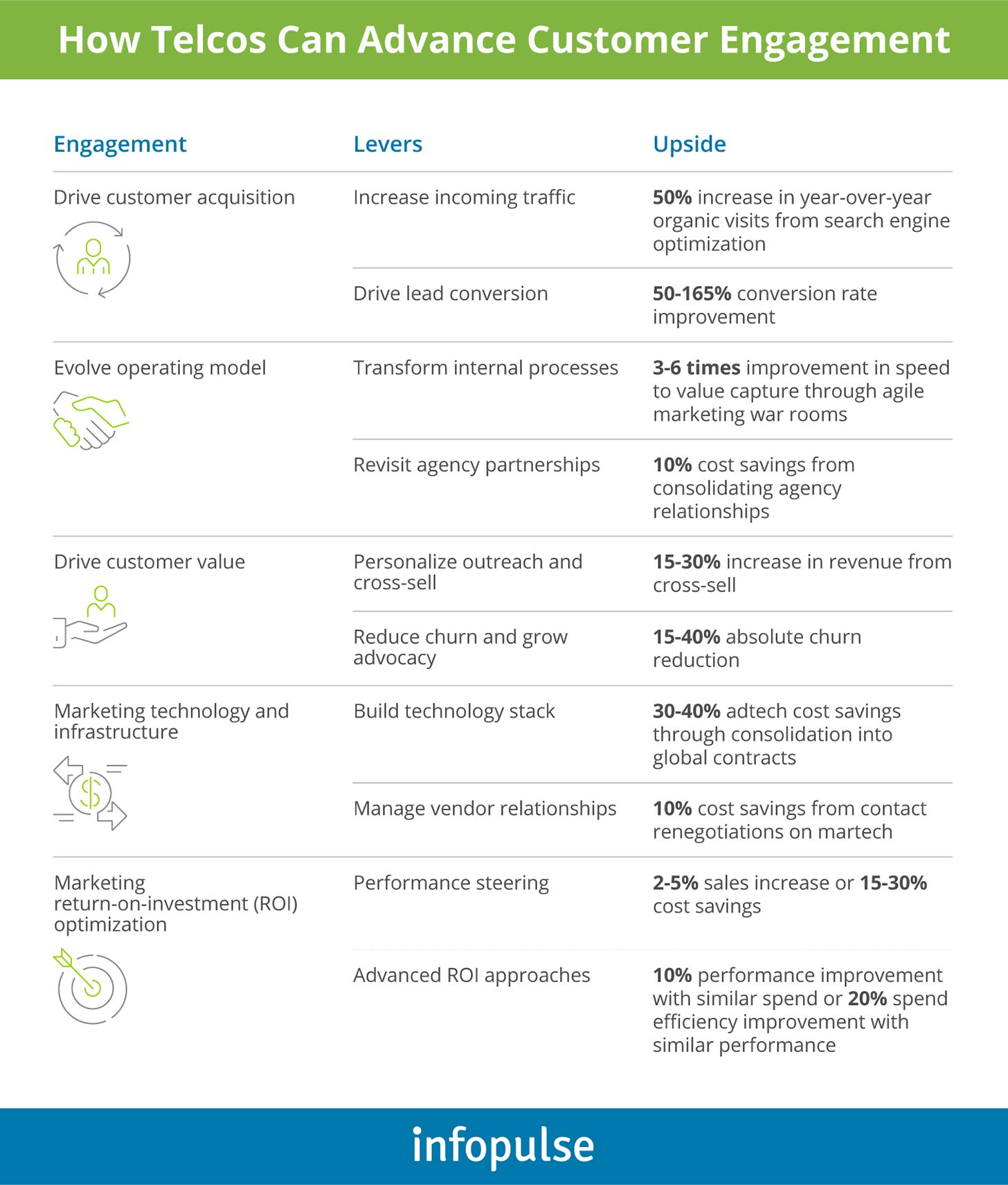
While processual implements in sales, marketing, and customer support operations are integral to harnessing improvements in customer experience and engagement, all of the initiatives will fall short unless they are backed by proper tech solutions.
In this post, we show how to improve customer experience in the telecom industry by investing in five technological areas.
1. Implement Mobile Solutions for End-to-End Customer Journeys
Much like in the banking sector, telecom customers now prefer fully digital onboarding performed remotely. The global pandemic has accelerated this trend further. With OTT players offering one-click service subscription, transparent billing schemes, and instant connectivity, traditional telcos urgently need to raise their bar when it comes to triple-play and quad-play digital sales.
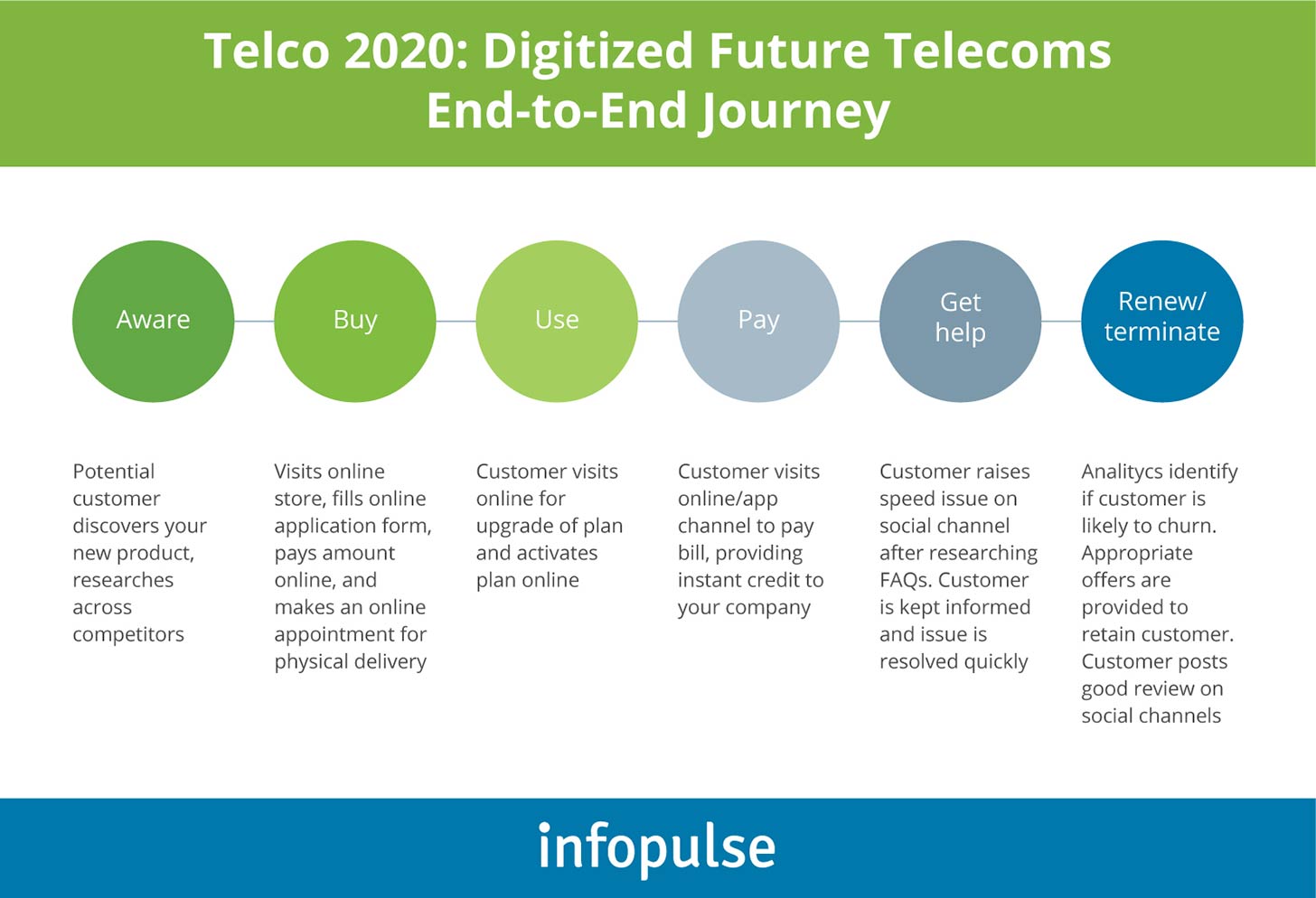
The customer journey outlined above may seem too futuristic for some telcos. But similar operational schemes have helped new players successfully penetrate the market as early as January 2012. That’s when Free Mobile, a French telecom company, entered the local market with its web-first triple play commercial model. The company committed to 100% online sales since day one, offering highly competitive subscription deals – unlimited voice calls, texts, data, and no roaming charges for €19.99 before tax. In less than four years, Free Mobile amassed 11 million subscribers and generated 40% of revenue for its parent company the Iliad.
A 2019 study from Bain also determined that telcos, practicing a simple and digital approach to their products and processes, outperform their peers in terms of customer loyalty and financial growth.
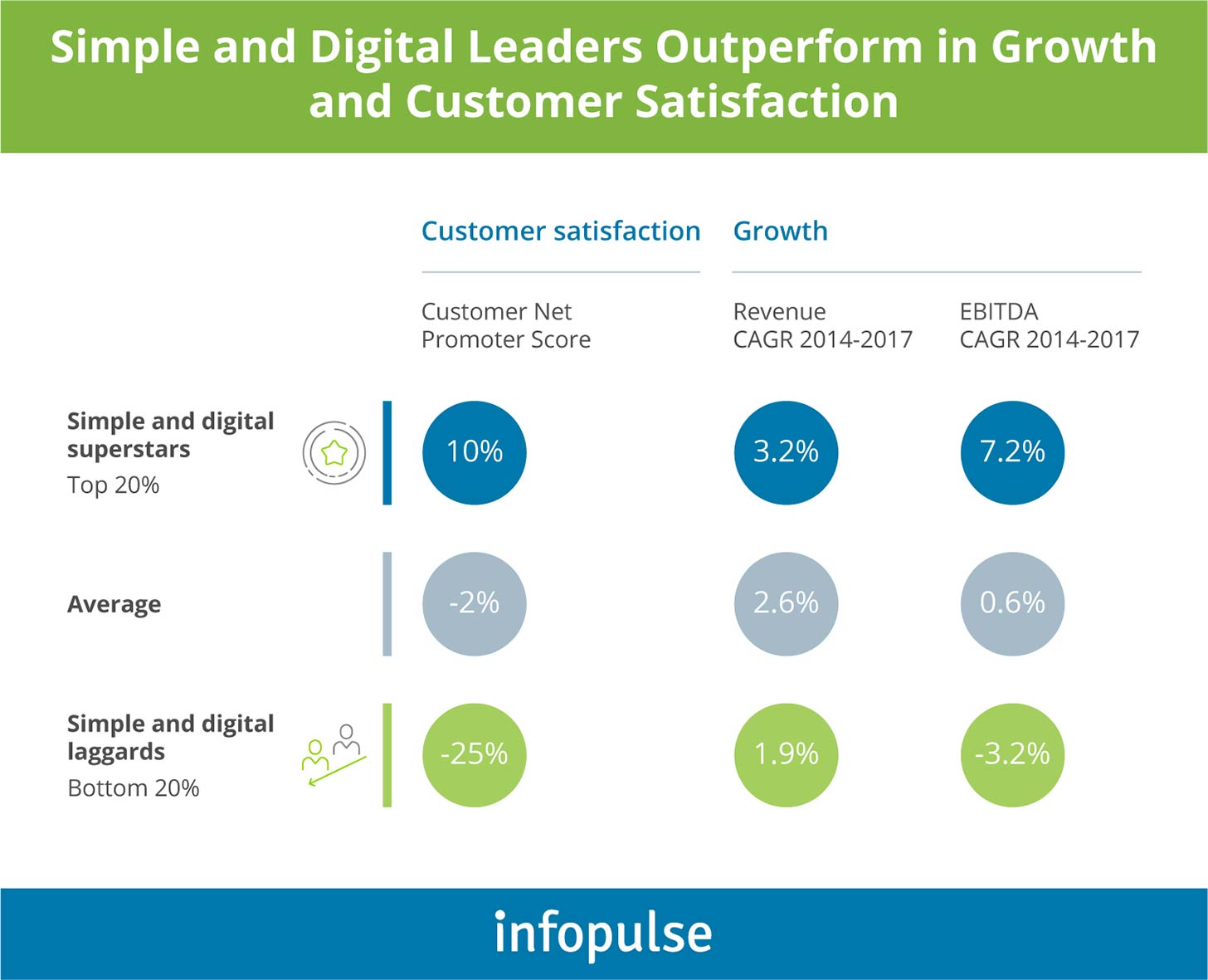
While your company may not be ready (yet) for a complete digital overhaul, you should at least consider introducing some telecommunication apps, tackling specific customer and business processes:
Telecom Customer Service App
According to a 2019 McKinsey survey, companies with a larger array of digital offerings have higher customer satisfaction scores. Besides, such companies also manage to reduce the cost-to-serve for each customer by 20%-40%.
While telephone support calls still remain a preferred contact method for 79% of consumers, an array of e-care solutions are also in the spotlight:
- Email – preferred by 78%
- Website/self-service – preferred by 60%
- App/mobile website – preferred by 44% and expected to increase to 49%.
That’s why digitizing your support operations only makes sense. Case in point: GiffGaff, a UK virtual network operator, has become the pioneer in e-care within the telecom industry. Their entire customer support staff rounds up to just 33 employees, with 50% of customer queries being solved in less than 3 minutes. Their secret? An extensive self-help library and community, backed-up by a mobile app reward program for participation. GiffGaff rewards active community participants with special points that can be traded for airtime credit, cash or donated to a charity of their choice.
T-Mobile NL followed a similar approach and launched a self-service portal that promotes peer-to-peer customer support. Within this growing community of 400,000 members, 65% of all queries get answered by other customers. This, in turn, translates into some $4 million in operational cost savings.
KYC (Know-Your-Customer) Apps
Collection of personal information about SIM users is a regulatory requirement in 85% of countries that results in a major paper trail during onboarding. A fully digital KYC is one of the latest trends in the telecom industry aimed at streamlining this key part of the onboarding process.
Instead of requesting to present an ID, new customers can be directed to the app to choose their service plan, snap a photo of the necessary ID documents for verification, add their payment details and track SIM card delivery. All the data will be automatically encrypted and securely transmitted to your central databases. Pairing a KYC app with a customer support app also reduces the hassle of verifying each prospect before offering them personalized support.
Sales Support App
A sales support app can facilitate in-person sales processes by giving your teams instant access to the right tools and information. Such apps can combine two distinctive areas of functionality:
- An internal dashboard that includes all the process information and sales procedures your sales team should follow when working with a prospect. It can also include sales forms that will allow your team to log data on the go and upload it to your central CRM. This way your agents won’t waste time on double-handling the data.
- A customer-facing area that gives a visual presentation of all your main offers; allows comparing your service plans, and guides the prospect further down the sales funnel.
Disaster Management Apps
Disaster management apps can reduce the load on your contact centers at times of disruption. They can help you segment and prioritize different customer queries, and direct your agents towards the most urgent issues. At the same time, the waiting customers with less pressing issues can be re-routed to a self-help section or a community portal, explaining to them how to:
- Find a stronger signal (using their location data)
- Connect to the closest public network
- Test the current speed of the connection
- Select the best carrier and configuration for their specific location
As you work further on determining the next candidates for digitization, consider running a customer service gap analysis using the SERVQUAL (service quality gap) model.
The aim of this model is two-fold:
- Identify current gaps between customer expectations and the actual services offered at different stages of service delivery.
- Close the gaps and improve overall customer service and experience.
This way you can launch a product that performs and delivers just the kind of service your customers expect to have.
2. Incorporate Big Data and Predictive Analytics
Telecom companies are in an interesting position. On one hand, they are already in possession of huge amounts of customer data siloed in their systems. On the other, most players still struggle to operationalize and transform that data into meaningful insights.
Predictive analytics in the telecom industry is at a nascent stage. However, the early pilots showcase that such investments can initiate significant payoffs, especially in terms of customer engagement and profitability. Consider just the following use cases:
Enhanced Customer Profiling
With the help of predictive analytics tools, telecommunication companies can transform the vast array of structured and unstructured voice of customer data into enriched customer profiles featuring:
- General Customer Information: customer ID, MSISDN, demographic, services used, spending pattern, usage plan, etc.
- Usage Data: CDR, VAS (value added services), average revenue, mobile Internet usage information.
- Device Data: brand, model, series, applications, technology used, device history.
- Location Data: current location, most visited location, roaming data, location services usage, etc.
Consolidating this data into one data lake and augmenting it further with external insights, can help your company personalize your approach to every customer and re-align your offers to match their needs.
Case in Point
SAS has worked with Rogers, Canada’s modern mobile communications network, on a new predictive data analytics solution. The new algorithm estimates how likely certain customers will be to promote or detract the company’s services to others. The new insights significantly improved Rogers’ sales team performance.
Additionally, using the collected data, the company customized voice call scripts to suit customer’s issues more precisely and personalized support on social media networks. As a result, Rogers lowered customer complaints by 53%.
Another telco deployed a predictive analytics app for their contact center. The new algorithm predicted the top three categories of incoming tickets for almost 80% of all calls. By receiving such a ‘heads up’, the specialists required 15% less time to troubleshoot a problem.
Behavior-Based Customer Insights
The current state of deep learning enables businesses to make highly accurate predictions. Such algorithms can be leveraged to forecast possible “churn” rates, identify at-risk prospects, and alert your teams to take immediate action.
McKinsey estimates that telcos which could identify and meet the shifting customer demands and behavior early on (with the help of advanced analytics), can secure a 30%-to-50% cash-flow improvement.
Marketing Mix Modeling
With the right data and algorithms in place, your company can precisely estimate the ROI of various marketing activities and predict customer response to different types of advertising. Linear regression models can be used to analyze the impact of different marketing campaigns on sales numbers and simulate different what-if scenarios prior to execution. This way you can identify and prioritize marketing spending on channels that offer better ROI and reduce overall budget waste.
Customer Sentiment Analysis
Lack of customer care leads directly to churn and reduced profits. Telecom companies, unfortunately, do not ace in this case. If you want to strengthen your brand, you will need to create new mechanisms for engaging with customers online. Sentiment analysis allows you to automatically capture and segment all customer conversations happening on social media and uncover new levers that can have a significant impact on your business.
You can take even further control over the sentiment around your brand by utilizing customer impact analysis and assessment models. In this case, your team can forecast how a proposed change, say to a data plan, will alter consumer behaviors and their sentiment; what effect it will have on the revenue, and how the overall customer experience will be altered.
Alternatively, if you are looking at how to measure customer engagement, customer sentiment analysis can be a solid asset for your digital contact centers. Such solutions can operationalize first-hand customer suggestions and gauge what your customers lack. One case study shows how a telecom company managed to reduce their volume of calls by 6% and raise CSAT from 66% to 84% by acting on the insights produced by the text analysis platform.
Unlock New Monetization Opportunities
Uncover an even deeper level of consumer insights with self-service BI running on top of your data warehousing and analytics platform. One of our clients, BICS, realized that a system capable to analyze over 2 billion records can help more than one business to succeed. So they have launched a dedicated BI service that helps their clients receive a 360-view of their roaming traffic performance, gain more insights into usage, revenue, behavior patterns, and improve their CX and service quality.
3. Launch a Voice of Customer Program
Telecom consumers are hard to impress over the long term, especially as OTT players move into the telcos turf. Telecom industry benchmarks state that user satisfaction with a provided line of services decreases universally at the one year mark and onward. The same thing occurs with a customer’s likelihood to recommend their provider:
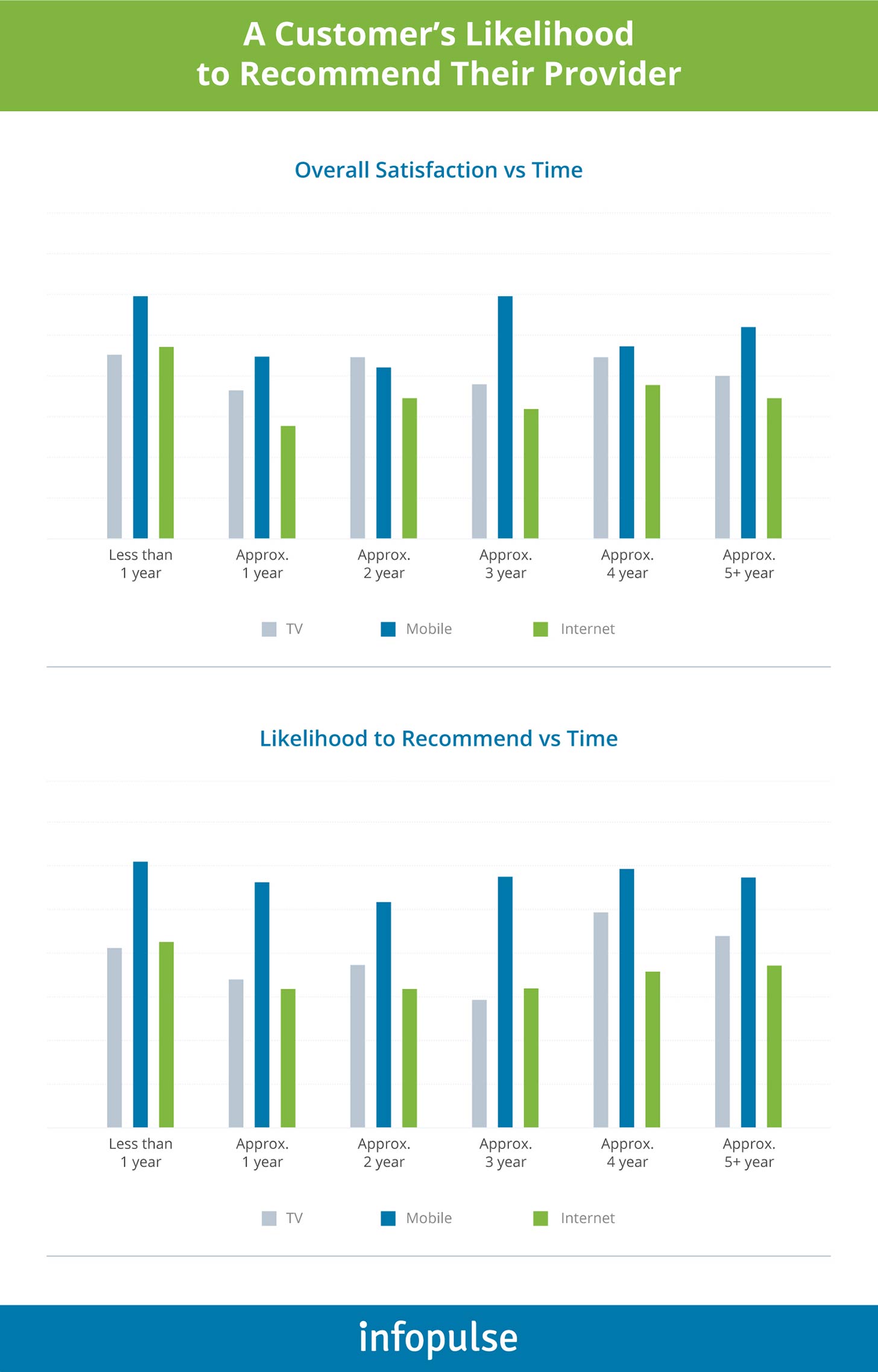
The current churn rates in the telecom industry are staggering:
- The average churn rate is 1.9% across the top four carriers in the US (AT&T, Verizon, T-Mobile, and Sprint).
- Monthly loss from the churn, per carrier, is $65M.
- Most frequently churn takes place at 19 months.
Some of the key factors affecting the telecom industry’s ability to retain customers are hardly new. A telecom survey by TechSee shows that most US customers (39%) named poor customer service as the primary reason for canceling their contracts. All of the other reasons for churn also correlates with low CX:
- 51% were unhappy with the fact that they had to call more than once to get their issue resolved.
- 37% canceled because the company wasted too much of their time.
- 37% cited bad experience with an agent as a determining factor.
- For 14%, inferior self-service options were a deal-breaker.
The digital support and analytics solutions we mentioned earlier can help you raise your levels of customer service. However, to ensure consistently high levels of customer engagement, you’ll also need to understand what it is exactly that they want. In short, that’s what a VoC program is designed to accomplish.
Voice of Customer analysis stands for the process of capturing and analyzing all the information your customers are saying about your business and products and applying the new insights to improve the overall customer experience in the telecom industry. VOC analytics can complement your customer path analysis and help you gain more insights into the motivation and needs of individual customers and specific segments. This data can help you pinpoint the most crucial areas for service improvement such as:
Customer Experience
Assess customers’ level of satisfaction at different touchpoints, their reasons for engaging with your website or customer support team and estimate their probability to churn.
Case in Point
A few years ago, Hong Kong engineers needed at least three hours to locate and fix a network fault. Such an outage negatively impacted the satisfaction of large corporate customers operating in the finance niche and resulted in numerous complaints and switching.
One local telecom provider invested in a new monitoring solution that reduced the response time to just 30 minutes. Whenever the system predicted an unavoidable outage, that provider notified customers in advance about the possible downtime and kept them in the loop on the fixes. As a result, the company managed to reduce complaints from high-revenue customers by 47% for 3G networks and 34% for 4G. Their churn rate dropped from double digits to just 1.5%.
Market and Competitive Intelligence
Understand what impacts consumers’ buying behavior at different stages of their journey; capture how social, political and environmental trends impact buying patterns; learn what customers say about your competitors.
Product/Service Management
Accumulate feedback on new services plans and special sales offers; gain more visibility into price sensitivity of different customer segments; identify the best performing promo offers and determine when to “retire” certain offers.
4. Modernize Your Systems to Support Omnichannel Customer Experience
The growth of digital services means that it’s no longer sufficient to optimize contact points individually. You have to create a synergic environment for your offline/online operations that delivers consistent brand experience across different digital touchpoints.
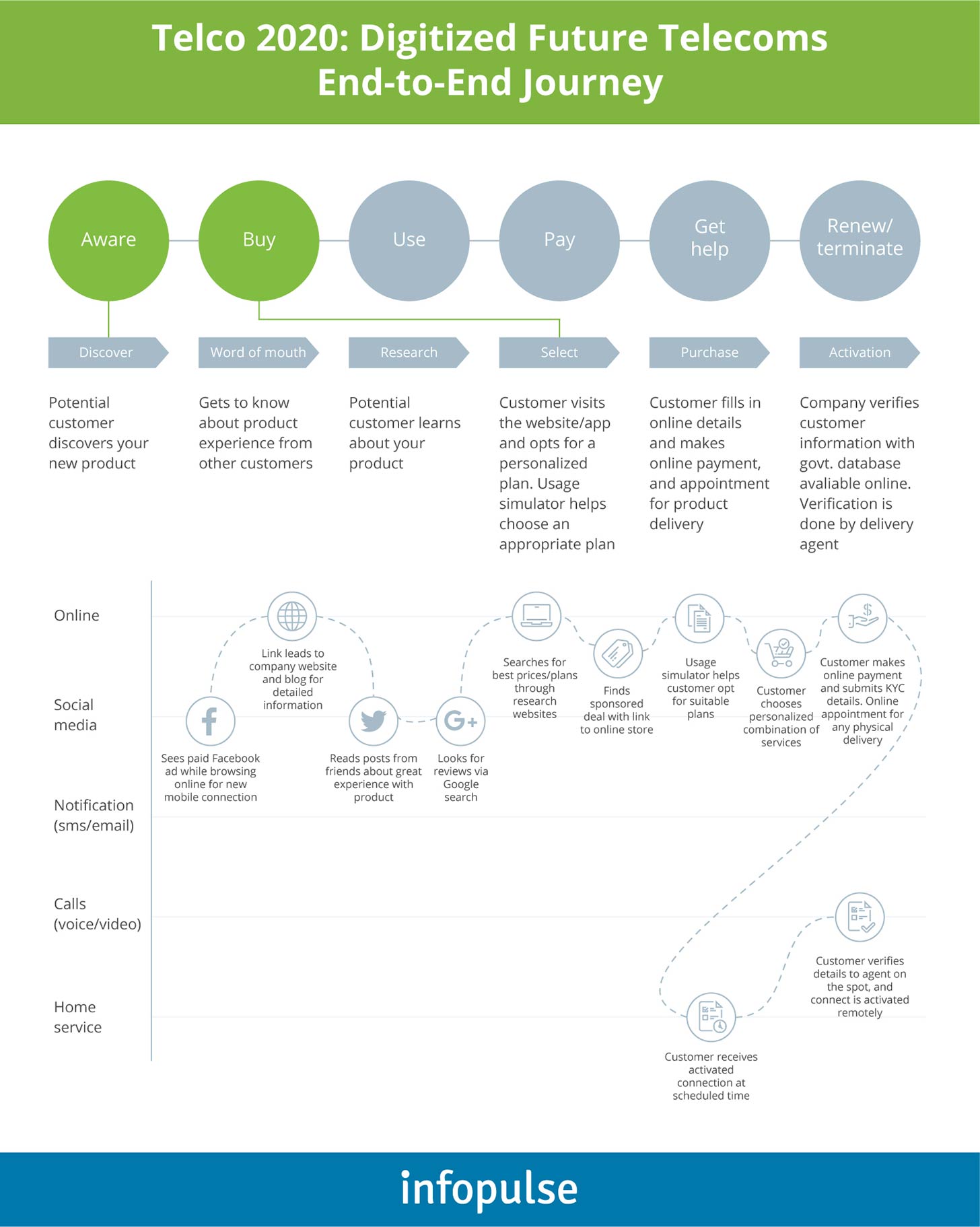
Clearly, a unified omnichannel experience requires careful orchestration and, in particular, weighted investments in legacy software modernization. If your end-goal is to roll-out a modern, fully-digital experience for all your customers, prioritize the following initiatives:
Refresh the Presentation Layer
Historically, most telecom applications were built using a siloed, monolith architecture. As a result, the look and “feel” of such apps is inconsistent, the navigation is confusing, and the CX is inconsistent from one service to another.
To address these issues, you can add a light unified UI layer, developed with JQuery, Angular, and Mustache and powered by a CMS (content management system). While this is certainly a ‘patch’ solution that does not solve the deeper system performance issue, it’s a solid first step that helps:
- Bring all digital apps and services to the same ‘branded’ look
- Address certain inefficiencies that prompt support calls
- Remove redundant/out-dated steps from your user flows.
De-Couple Your Core
The next, and far more crucial, task on your agenda should be legacy core modernization. In particular, look into ways to decouple the monolith platform and migrate towards microservices architecture – a tech setup that is more conducive to the deployment of new digital services. KYC, digital onboarding, online payments, e-care, and other digital product components can be built as separate services connected using APIs. Additionally, you can “plug” an array of external services via APIs to scale your functionality without developing it in-house.
Also, by building a strong API ecosystem you can later connect extra proprietary assets such as (smart kiosks, POS systems, tablets, IoT gadgets) to your core and streamline data exchanges between them. Doing so will help you gain a more unified view of your operations, plus collect a wide array of customer insights.
Implement Customer Analytics Solutions
To be successful in the omnichannel environment, you need to maintain a single-pane view into customer behaviors across various touchpoints. You should establish a clear process for collecting and consolidating all the relevant data to a centralized data management platform configured in line with the latest data security and compliance best practices.
After assembling a strong base, you can select the optimal analytics solution for your use cases:
- An off-the-shelf customer journey analytics software
- Proprietary or off-the-shelf Big Data analytics solutions
- Self-service BI and analytics solutions
- Predictive analytics models, developed for specific use cases
Learn more about Infopulse’s approach to building innovative business analytics solutions.
5. Invest in AI-Powered Chatbots to Boost Service Levels
Chatbots may seem like a tantalizing opportunity for telcos as they offer significant cost savings through automation. However, customer sentiment towards the ‘bot’ isn’t as receptive. The earlier mentioned Ericsson survey states that 60% of consumers are afraid that chatbots won’t be able to understand their customer care issues as well as human agents.
While the modern state of cognitive technologies –ML, AI, and Natural Language Processing – allows building truly intelligent chatbots, telecoms should strive to find the optimal balance between digital and traditional channels to maximize customer experience.
To ensure high levels of customer satisfaction, model your AI-driven support process around the following tiers:
- Set up a self-service portal and augment information search using conversational AI to deal with the most basic queries.
- Pair your human agents with AI bots that would serve them the right customer information and help pre-fill replies to recurring questions.
- Set up a seamless transition from a chatbot to a live chat agent to minimize disruptions for the customer.
- Experiment with voice-based assistants to help with call rerouting and preliminary information collection.
- Reserve the telephone support channel for the most urgent and complex customer issues to free up your staff.
Beyond customer support, conversational AI technology is also seeing success in sales.
CenturyLink’s chatbot called Angie is now in charge of the company’s customer outreach. It sends around 30,000 emails per month, identifies the most promising leads, and routes those to the right reps. So far, it has earned $20 in new contracts for every dollar it spent on the system.
To Conclude
There’s no pedaling back – a customer experience revolution is already taking place. As a telecom company, you can either focus on improving your customer service levels and engagement strategies with digital solutions or watch tech-led companies overtake you both in established and new markets.
If you are ready to prioritize your CX, our Infopulse team can become your trusted partner in building an innovative dialogue with your customers. We have extensive experience in the telecommunication industry and have been assisting BICS in their transformational journey since 2010. Contact us!


![CX with Virtual Assistants in Telecom [thumbnail]](/uploads/media/280x222-how-to-improve-cx-in-telecom-with-virtual-assistants.webp)
![Power Apps Licensing Guide [thumbnail]](/uploads/media/thumbnail-280x222-power-apps-licensing-guide.webp)
![Expanding NOC into Service Monitoring [thumbnail]](/uploads/media/280x222-best-practices-of-expanding-telecom-noc.webp)
![Cloud-Native for Banking [thumbnail]](/uploads/media/cloud-native-solutions-for-banking_280x222.webp)
![Generative AI and Power BI [thumbnail]](/uploads/media/thumbnail-280x222-generative-AI-and-Power-BI-a-powerful.webp)
![Data Governance in Healthcare [thumbnail]](/uploads/media/blog-post-data-governance-in-healthcare_280x222.webp)
![Super Apps Review [thumbnail]](/uploads/media/thumbnail-280x222-introducing-Super-App-a-Better-Approach-to-All-in-One-Experience.webp)
![SAP Service Insight [thumbnail]](/uploads/media/Service Insight-Infopulse-SAP-Vendor-280x222.webp)
